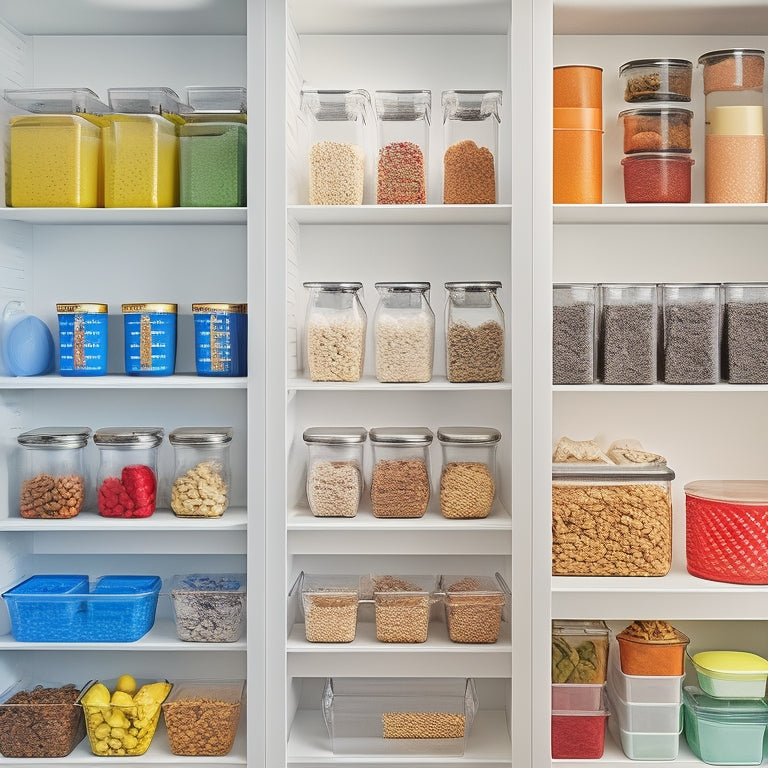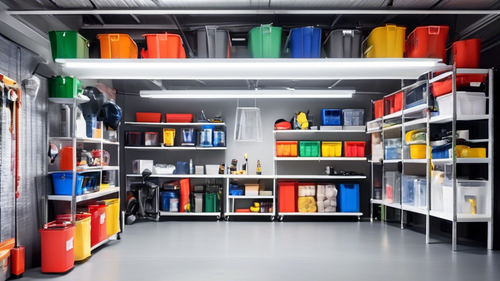
Pantry Storage Bins and Labeling Essentials
Share
You're on a mission to optimize your pantry's storage and labeling systems. Start by choosing durable, easy-to-clean storage bins that fit snugly on your shelves. Adopt a "one in, one out" policy to prevent clutter accumulation. Implement a labeling system with clear, concise descriptions and consistent placement to reduce search time. Consider color coding, digital labels, and item-specific bins for maximum efficiency. By pairing the right storage bins with a thoughtful labeling system, you'll be well on your way to a pantry that's both beautiful and functional - and there's even more to investigate to take your pantry organization to the next level.
Key Takeaways
- Choose durable, easy-to-clean storage bins made of materials like plastic or stainless steel to ensure longevity and simplify maintenance.
- Implement a labeling system with clear, concise descriptions and consistent placement to facilitate quick identification and access.
- Select bins of various sizes to accommodate different items, such as larger bins for bulk items and smaller bins for spices or oils.
- Use a "one in, one out" policy to prevent clutter accumulation and maintain a balanced pantry inventory.
- Consider color coding and digital labels to enhance visual organization and make it easier to locate specific items.
Choosing the Right Storage Bins
Clarity reigns when your pantry storage is a well-organized haven. You're in control when you choose the right storage bins.
Material selection is key - consider bins made of durable, easy-to-clean materials like plastic or stainless steel. Avoid flimsy or fragile materials that may break or deteriorate over time.
To maintain organization, adopt a one in, one out policy Streamlining Personal Belongings and regularly revisit your pantry storage to prevent clutter accumulation.
Size considerations are also essential - measure your pantry shelves and select bins that fit snugly, maximizing storage capacity.
Don't forget to think about the items you'll be storing - larger bins for bulk items, smaller bins for spices or oils.
Labeling Systems for Easy Access
With your pantry storage bins in place, it's time to take your organizational system to the next level by implementing a labeling system that allows you to quickly identify what's inside each bin. This will save you time and frustration when searching for specific ingredients or supplies.
A well-designed labeling system helps you maintain control over your pantry's contents and guarantees everything has its designated place.
You can create an effective labeling system by incorporating the following elements:
- Color coding: Use different colors to categorize similar items, such as baking supplies or snacks.
- Digital labels: Print or write labels using a digital tool to guarantee consistency in font and layout.
- Clear descriptions: Use concise and descriptive labels that clearly indicate what's inside each bin.
- Consistent placement: Place labels in the same location on each bin to create a visual routine.
Maximizing Vertical Pantry Space
By installing shelves, hooks, or baskets, you can release the full potential of your pantry's vertical space, allowing you to store more items without sacrificing accessibility. This is especially important for small pantries, where every inch counts. To make the most of your vertical space, consider using:
| Product | Description | Benefits |
|---|---|---|
| Shelf Risers | Raise items for easier access | Increased visibility, reduced bending |
| Tiered Organizers | Stackable containers for efficient storage | Maximize storage capacity, easy to clean |
| Wall Mounted Racks | Hang items like baskets or bags | Saves floor space, keeps items off countertops |
Creating a Functional Pantry Layout
Now that you've maximized your pantry's vertical space, it's time to think about the layout. A functional pantry layout is essential for easy access and efficient cooking.
To create one, you'll need to implement pantry zoning and ingredient categorization. This means dividing your pantry into zones, such as baking, cooking, and snacks, and categorizing ingredients within those zones.
Here are some key considerations for your pantry layout:
-
Zone placement: Place frequently used zones at eye level, and less frequently used zones above or below.
-
Ingredient categorization: Group similar ingredients together, such as all baking supplies or all spices.
-
Bin placement: Position bins near the zone they correspond to, making it easy to restock and access ingredients.
- Aisle width: Verify the aisles between shelves are wide enough for comfortable movement.
Maintaining Pantry Organization Habits
You've designed a functional pantry layout, complete with zones and categorized ingredients, making it easy to find what you need when you need it.
Now, it's crucial to maintain this organization by implementing pantry decluttering techniques. Set aside time each week to tidy up your pantry, confirming everything is in its designated zone.
Perform a deeper clean every season to rotate seasonal ingredients and remove expired items. This routine will prevent clutter from building up and keep your pantry organized.
Additionally, establish a "first in, first out" rule for perishable items to guarantee you're using the oldest items before they expire.
Frequently Asked Questions
Can I Use Pantry Storage Bins in Other Areas of My Home?
You can repurpose storage bins in other areas of your home, exploring creative uses beyond the pantry. Try organizing tips like storing toys, linens, or office supplies, and uncover how versatile these bins can be in maintaining control over your space.
Are Pantry Storage Bins Dishwasher Safe?
You're wondering if your storage bins can withstand the dishwasher's heat and harsh materials. Check the manufacturer's guidelines, as durability varies; some bins are designed for dishwasher safety, while others may degrade or warp, so it's crucial to verify before tossing them in.
Can I Stack Plastic Pantry Storage Bins on Top of Each Other?
As you build your towering monument of organization, you wonder if it'll come crashing down. Rest assured, with careful stacking techniques and a focus on bin stability, you can safely stack plastic storage bins, creating a sturdy fortress of efficiency that'll make you feel like a skilled designer.
How Do I Clean Pantry Storage Bins With Stubborn Stains?
You'll tackle stubborn stains in pantry storage bins by mixing baking soda and water to create a paste, applying it to the stain, and letting it sit before scrubbing with a gentle brush and rinsing with warm water for effective stain removal.
Are Pantry Storage Bins Suitable for Storing Pet Food?
When storing pet food, you'll want to guarantee proper preservation. Look for storage bins made from pet-safe, BPA-free materials like stainless steel or food-grade plastic, which won't contaminate or absorb odors, keeping your pet's food fresh and healthy.
Related Posts
-

Ceiling Storage Solutions for Your Garage
Unlocking the Sky's the Limit with Ceiling Storage Solutions for Your Garage Declutter and Maximize Your Space with ...
-

What's Holding You Back From Digital Simplicity?
You're struggling to achieve digital simplicity due to fear of overwhelm from technology anxiety, information overloa...

